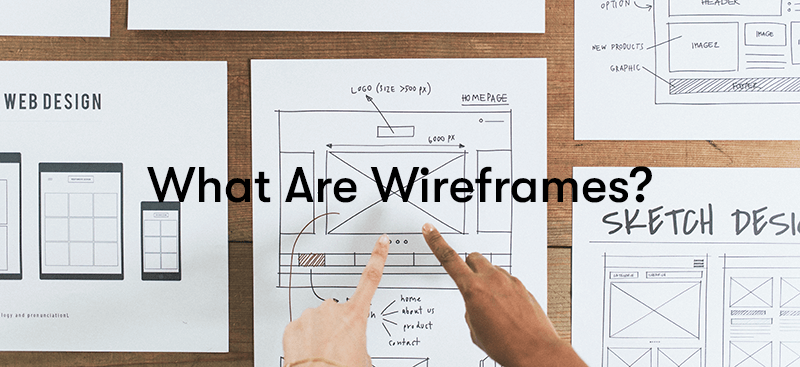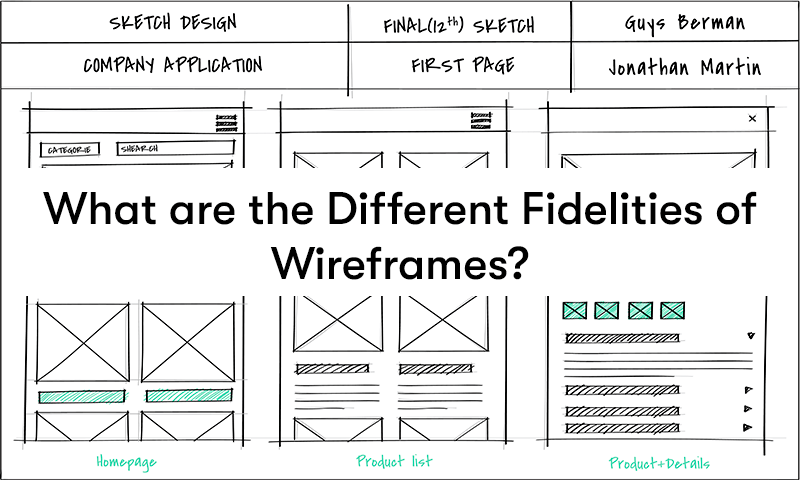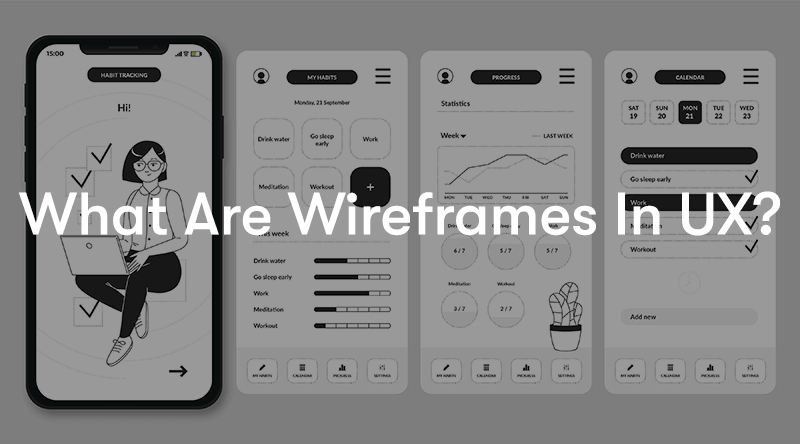What Are Wireframes In UX?
In this Blog, we delve into the world of wireframes, a pivotal tool in crafting exceptional digital experiences. Wireframes, a vital UX (User Experience) design component, serve as the architectural blueprints, outlining a digital product's skeletal structure and layout. We'll unravel their significance in clarifying design intent, early issue detection, and iterative design.
We will discuss how wireframes differ from prototypes and mock-ups, highlighting their unique roles in the design process. Join us on this journey to understand how wireframes shape the user-centred design landscape.
What Are Wireframes?

Wireframes are a visual representation or blueprint that focuses on the layout and structure of a digital product, such as a website or mobile app, to create a user-friendly and intuitive experience. UX wireframes help designers and teams plan how users interact with a product and ensure that the design meets user needs and expectations.
UX wireframes are an essential part of the UX design process, helping teams plan and refine user interfaces to create products that are not only visually appealing but also user-friendly and efficient in achieving their intended purpose. They bridge the gap between initial concepts and the detailed design phase, ensuring that the user's needs are at the forefront of the design process.
How Are Wireframes Used in UX?

Wireframes are a crucial tool in User Experience design, as they play several essential roles in the design and development process. Here's how wireframes are used in UX:
Conceptualising Ideas
Wireframes are often one of the first steps in the UX design process. They help designers and teams conceptualise their ideas by providing a visual representation of the product's layout and structure. This early visualisation is essential for aligning stakeholders and establishing a shared vision for the project.
Defining Layout and Structure
Wireframes focus on defining the layout and structure of a digital product, such as a website or mobile app. They outline the placement of key user interface elements, including navigation menus, buttons, forms, and content areas. This ensures that the product is organised in a user-friendly and logical manner.
Content Planning
Wireframes help designers plan the placement of content within the interface. This includes determining where text, images, videos, and other media elements will be located. Content planning is crucial for creating a practical and engaging user experience.
User Flow Visualisation
Many wireframes include annotations or diagrams illustrating how users navigate the product. This helps designers and stakeholders understand the user flow and the sequence of interactions required to accomplish specific tasks or goals.
Usability Testing
Wireframes can be used in usability testing sessions to gather feedback from potential users. Test participants can interact with the wireframes and provide input on the layout, navigation, and overall user experience. This feedback informs design improvements before the development phase.
Stakeholder Communication
Wireframes serve as a communication tool among project stakeholders, including designers, developers, product managers, and clients. They provide a visual reference for discussing design concepts, making decisions, and ensuring everyone is on the same page.
Iterative Design
Wireframes support an iterative design process. Designers can create multiple versions of wireframes to explore different design ideas and concepts. Feedback from usability testing and stakeholder reviews can then be used to refine and improve the wireframes and, subsequently, the final design.
Prototyping Basis
Wireframes can serve as the foundation for creating interactive prototypes. Designers can build interactive prototypes by adding functionality to the wireframes, allowing stakeholders to experience and test the product's usability before development begins.
Responsive Design Planning
Wireframes can be created for different screen sizes and devices, helping designers plan for responsive design. This ensures that the product's layout and functionality adapt effectively to various screen resolutions and orientations.
Documentation
Wireframes can be used as documentation for development teams. They provide a clear reference for developers to understand the design requirements and implement the user interface accurately.
In summary, wireframes are a versatile tool in the UX design process, bridging initial concepts and detailed design. They facilitate collaboration, user-centred design, and usability testing, ultimately leading to the creation of user-friendly and effective digital products.
Why Are Wireframes Important for User Experience?

Wireframes are crucial for UX for many reasons including:
Clarity of Design Intent
Wireframes visually represent a digital product's layout and structure without distracting visual details. They help convey the intended design to stakeholders, ensuring that everyone involved clearly understands the project's direction.
User-Centred Design
Wireframes help keep the focus on the user. They enable designers to plan and arrange interface elements based on user needs and behaviours, ensuring that the user experience takes precedence in the design process.
Early Problem Identification
By creating wireframes early in the design process, UX designers can identify and address potential usability issues before investing significant time and resources in detailed design or development. This proactive approach saves time and reduces the cost of making changes later in the process.
Iteration and Feedback
Wireframes are flexible and can be easily modified. Designers can use them to gather feedback from stakeholders and conduct usability testing to make iterative improvements, leading to a more refined and user-friendly design.
Efficient Communication
Wireframes serve as a common language among project stakeholders. They facilitate communication between designers, developers, product managers, and clients by providing a visual reference that everyone can understand and discuss.
Focus on Functionality
Wireframes emphasise functionality over aesthetics. This ensures the product's core features and interactions are well-planned and aligned with user expectations before considering visual design elements.
Usability Testing
Wireframes are ideal for usability testing, allowing designers to test the product's user flow and interaction design early in the process. This helps identify potential usability issues and validate design decisions.
Responsive Design Planning
Wireframes can be created for different screen sizes and devices, helping designers plan for responsive design. This ensures that the user experience remains consistent and effective across various platforms.
Documentation for Development
Wireframes serve as valuable documentation for development teams. They provide developers with a clear blueprint for implementing the user interface, reducing the risk of misinterpretation and ensuring that the final product aligns with the UX design.
Cost-Effective Design
Wireframes are more cost-effective to create and modify than high-fidelity designs or fully developed prototypes. This makes them an efficient tool for exploring and refining design ideas.
Wireframes are a critical tool in the UX design process because they help designers create user-centred, efficient, and effective digital products. They contribute to better communication, early issue identification, and iterative design, ultimately leading to improved user experiences and a more successful product.
Wireframes vs Mock-ups vs Prototypes - What's the Difference?
Wireframes, mock-ups, and prototypes are distinct stages in the design and development process, each serving a different purpose and level of detail. Here's a breakdown of the differences between them:
Wireframes Overview
Purpose: Wireframes are the earliest stage in the design process and focus on a digital product's layout, structure, and functionality.
Detail: They are low-fidelity and lack visual styling, such as colours, images, and detailed graphics. Instead, they use basic shapes, lines, and labels to represent interface elements.
Interactivity: Wireframes are static and non-interactive. They provide a visual blueprint for the design but do not simulate user interactions or functionality.
Use Cases: Wireframes are used for conceptualising ideas, outlining content placement, defining user flow, and getting feedback on the overall layout and structure. They are primarily a communication and planning tool.
Mock-ups Overview
Purpose: Mock-ups come after wireframes and focus on a digital product's visual design and aesthetics.
Detail: They are medium-fidelity, featuring visual elements like colours, typography, images, and icons. Mock-ups aim to represent how the final product will look.
Interactivity: Mock-ups are generally static but may include clickable elements to showcase visual design and layout in greater detail. However, they do not typically simulate complex interactions.
Use Cases: Mock-ups are used to refine the visual design, establish a cohesive brand identity, and gain approval from stakeholders before moving on to the development phase. They are often used in marketing and presentations.
Prototypes Overview
Purpose: Prototypes are a more advanced stage and focus on demonstrating a digital product's functionality and user interactions.
Detail: They can be high-fidelity and closely resemble the final product, including visual design and styling. However, their main emphasis is on interactivity and user experience.
Interactivity: Prototypes are interactive and allow users to interact with the product as they would in the real world. They can simulate user flows, transitions, and user input, making them suitable for usability testing and user validation.
Use Cases: Prototypes are used to test and validate the user experience, refine interaction design, and identify usability issues. They are often used to gather user feedback and insights.
In summary
Wireframes are for layout and structure, focusing on functionality and user flow, and are low-fidelity and non-interactive.
Mock-ups are for visual design, emphasising colours, typography, and aesthetics, and are medium-fidelity with limited interactivity.
Prototypes are for demonstrating functionality and user interactions, with a focus on high-fidelity and interactivity to simulate the user experience.
The choice of which to use at a given stage depends on the project's goals and the need to communicate, design, or test specific aspects of the digital product. Often, these stages are iterative, with designers refining their work as they progress from wireframes to mock-ups and eventually to prototypes.
What Are the Different Fidelities of Wireframes?

Wireframes can be created at different levels of fidelity, depending on the project's needs and where it stands in the design process. Fidelity refers to the level of detail and complexity in the wireframe. Here are the main categories of wireframe fidelity:
Low-Fidelity Wireframes:
Purpose: Low-fidelity wireframes are used in the early design stages to quickly and roughly sketch out ideas and concepts. They are primarily for brainstorming and exploration.
Detail: They are basic and minimalistic. They use simple shapes, lines, and placeholders to represent interface elements. They typically do not include any visual styling, such as colours or typography.
Interactivity: Low-fidelity wireframes are static and non-interactive. They do not simulate user interactions or functionality.
Use Cases: Low-fidelity wireframes are ideal for initial idea generation, concept validation, and a starting point for stakeholder discussions. They are quick to create and allow for rapid iteration.
Mid-Fidelity Wireframes:
Purpose: Mid-fidelity wireframes strike a balance between simplicity and detail. They are used to refine concepts, establish content hierarchy, and plan the layout more precisely.
Detail: They include more detail than low-fidelity wireframes but are still relatively simple. They may use basic visual styling like grayscale colours, simple fonts, and icons. Content is more clearly defined.
Interactivity: Mid-fidelity wireframes are generally static but may include limited interactivity through clickable elements to demonstrate user flow or navigation.
Use Cases: Mid-fidelity wireframes are suitable for presenting concepts to stakeholders and gathering feedback on content placement, navigation, and overall user experience. They can also serve as a foundation for more detailed design work.
High-Fidelity Wireframes:
Purpose: High-fidelity wireframes are used when designers need to closely represent the final product's look and feel. They focus on visual design and detail.
Detail: They include visual styling such as colours, typography and even images. Interface elements are well-defined and closely resemble the final design. High-fidelity wireframes often look more like polished designs.
Interactivity: High-fidelity wireframes may include limited interactivity to showcase design and user flow. They can simulate user interactions to a certain extent but are not fully functional prototypes.
Use Cases: High-fidelity wireframes are used for design approval, client presentations, and refining visual design elements. They help stakeholders visualise the final product's appearance and allow for detailed design discussions.
The choice of wireframe fidelity depends on the project's stage, goals, and audience. Low-fidelity wireframes are suitable for early exploration, mid-fidelity wireframes are used for refining design concepts, and high-fidelity wireframes are employed for visual design and presentations. Often, designers progress through these levels of fidelity as they iterate on their designs and move closer to the final product.
Benefits of Using Wireframes for UX

Using wireframes in the UX design process offers several benefits that contribute to creating user-friendly, effective digital products. Here are some of the key advantages:
Clarity of Design Intent
Wireframes provide a clear and visual representation of the product's layout and structure, helping stakeholders, including designers, developers, and clients, understand the design direction and intent early in the project.
Focus on Functionality
Wireframes emphasise functionality and user flow over visual design details. This ensures the product's core features and interactions are well-planned and aligned with user needs before adding aesthetics.
Efficient Communication
Wireframes serve as a common language among project stakeholders. They facilitate effective communication by providing a visual reference for discussing design concepts, making decisions, and ensuring everyone is on the same page.
Early Problem Identification
Wireframes help identify potential usability issues and challenges in the design early in the process. Addressing these issues at the wireframing stage is more cost-effective than making changes later during development.
Iterative Design
Wireframes support an iterative design process. Designers can create multiple versions of wireframes to explore different design ideas and concepts. Feedback from usability testing and stakeholder reviews can then be used to refine and improve the wireframes.
User-Centred Design
Wireframes keep the focus on the user. They help designers plan and arrange interface elements based on user needs and behaviours, ensuring the user experience is at the forefront of the design process.
Responsive Design Planning
Wireframes can be created for different screen sizes and devices, helping designers plan for responsive design. This ensures that the user experience remains consistent and effective across various platforms.
Usability Testing
Wireframes can be used in usability testing sessions to gather feedback from potential users. Test participants can interact with the wireframes and provide input on the layout, navigation, and overall user experience.
Cost-Efficient Design
Wireframes are more cost-effective to create and modify than high-fidelity designs or fully developed prototypes. This makes them an efficient tool for exploring and refining design ideas.
Documentation for Development
Wireframes serve as valuable documentation for development teams. They provide developers with a clear blueprint for implementing the user interface, reducing the risk of misinterpretation and ensuring that the final product aligns with the UX design.
In summary, wireframes are a fundamental tool in the UX design process that helps streamline communication, identify and address usability issues early, and keep the user's needs at the forefront of the design. They contribute to efficient design iterations and, ultimately, lead to the creation of user-friendly and effective digital products.
Benefits of Using Wireframes Outside of UX?
While wireframes are most commonly associated with UX design, they can also offer significant benefits when used outside of the UX context. Here are some advantages of using wireframes in other domains:
Clarity and Visualisation
Wireframes visually represent ideas, concepts, or plans, making it easier for teams and stakeholders to understand complex projects or processes. They help in communicating design intent and layout across various fields.
Efficient Planning
In architecture and interior design, wireframes (often referred to as blueprints or floor plans) are essential for planning the layout of physical spaces, determining room dimensions, and positioning structural elements like walls, doors, and windows.
Process Flow Mapping
In business process analysis and workflow optimisation, wireframes can be used to visualise the flow of tasks and activities within an organisation. They help identify bottlenecks, inefficiencies, and areas for improvement.
Prototyping for Industrial Design
In industrial design and product development, wireframes (or physical prototypes) are used to create 3D models or physical representations of products, enabling designers and engineers to assess form, fit, and function.
Web Development
Beyond UX design, wireframes are also valuable in web development for planning site architecture, page layouts, and content placement. They assist in clarifying the structure of a website or web application.
Marketing and Advertising
Wireframes can be used in marketing and advertising to plan the layout and content placement for advertisements, brochures, and marketing materials. They help ensure that key messages are effectively communicated.
Storyboarding in Film and Animation
In film, animation, and video production, wireframes (often called storyboards) are used to plan the sequence of shots, camera angles, and visual storytelling elements. They provide a blueprint for the final production.
Game Design
In the field of game design, wireframes are used to create the initial sketches and layouts for game levels, characters, and interfaces. They help game designers plan game mechanics and interactions.
Software Development
In software development, wireframes can be used for planning user interfaces, database schemas, and data flow diagrams. They help developers understand the structure of a software application.
Educational Planning
In education, wireframes can be used to create course outlines, lesson plans, and curriculum maps. They help educators visualise the sequence of topics and learning objectives.
Urban Planning
In urban planning and city design, wireframes (referred to as master plans or zoning diagrams) are used to outline the arrangement of buildings, roads, parks, and infrastructure in a city or neighbourhood.
Art and Illustration
Artists and illustrators use wireframes to sketch their artwork's basic shapes and composition before adding details. Wireframes help in planning the overall structure and proportions.
In these contexts, wireframes serve as a versatile tool for planning, communicating, and visualising ideas and concepts across different disciplines. They offer clarity, efficiency, and the ability to iterate on designs or plans, making them valuable outside the traditional UX design field.
Where Can You Learn More About UX?
Our BCS Foundation Certificate in User Experience training course is perfect for anyone who wants to increase their knowledge of User Experience. The BCS User Experience course will teach you the UX methodology, best practices, techniques, and a strategy for creating a successful user experience. The course will cover the following topics:
- Guiding Principles.
- User Research.
- Illustrating The Context ff Use.
- Measuring Usability.
- Information Architecture.
- Interaction Design.
- Visual Design.
- User Interface Prototyping.
- Usability Evaluation.
Click the button below to find out more.

Final Notes On Wireframes In UX?
These visual blueprints, often associated with User Experience design, extend their benefits far beyond that domain. Wireframes offer clarity, efficiency, and enhanced communication in architecture, process mapping, industrial design, marketing, education, and more.
Wireframes become indispensable tools for planners, designers, and creators across various fields by simplifying complex concepts into visual representations. They streamline decision-making, facilitate collaboration, and enable precise planning.
Whether in digital or physical realms, wireframes are the universal language of design and innovation, enhancing projects and processes beyond the boundaries of UX.



